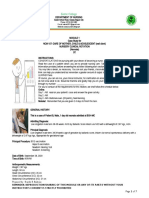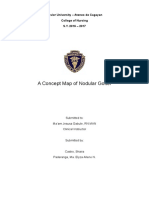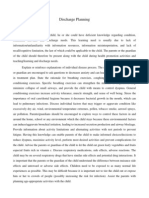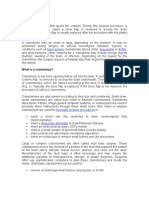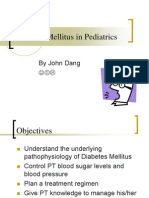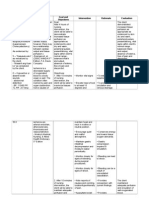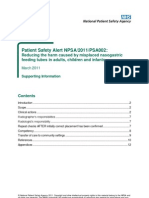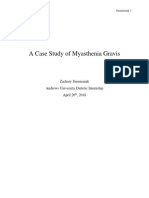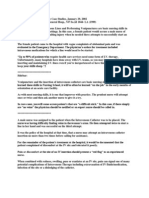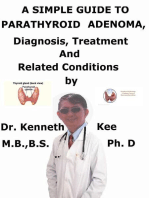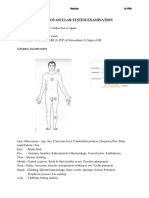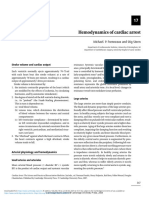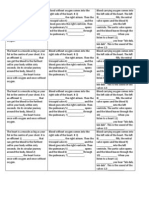Mitral Valve Prolapse
Mitral Valve Prolapse
Uploaded by
Mindy Leigh LayfieldCopyright:
Available Formats
Mitral Valve Prolapse
Mitral Valve Prolapse
Uploaded by
Mindy Leigh LayfieldOriginal Description:
Copyright
Available Formats
Share this document
Did you find this document useful?
Is this content inappropriate?
Copyright:
Available Formats
Mitral Valve Prolapse
Mitral Valve Prolapse
Uploaded by
Mindy Leigh LayfieldCopyright:
Available Formats
Pathophysiology Worksheet Expected Lab Ranges (WNL):
Disease Process: MITRAL VALVE PROLAPSE
Pathophysiology
instead of the flaps of the valves remaining closed during ventricular systole, one or both valves bulge
backwards into the left atrium (can lead to MVR if the bulging flaps do not fit together) *this increase
pressure on the papillary muscles leads to further mitral dysfunction.
_______________________________________________________________________________
Risk Factors
hereditary disorders, infection that damages the mitral valve such as endocarditis, cardiomyopathy *it
is the most common VHD and occurs mostly in women between 15-30, who and thin and have slight
chest abnormalities
Expected Findings
Usually no symptoms and have a good prognosis – severity can range from a murmur heard at the
apex, mid-systolic to chordae tendinea rupture, which can lead to MVR– may include chest pain not
related to exertion, dysrhythmias, palpitations, syncope, fatigue, dyspnea, or anxiety
Diagnostics/Laboratory Data
Auscultating for a clicking sound by the stress on chordae tendinea or leaflets when they prolapse or a
murmur if blood is leaking into the LA – ECG (although is it usually normal – you may see inverted T
waves, indicating ischemia) – echocardiogram with doppler can identify MVP, coronary angiogram
can show visualization of bulging flaps.
Nursing Care/Interdisciplinary Care
Unless severe, it requires no treatment. Nursing care if symptomatic could include dangling before
standing to prevent orthostatic hypotension or syncope, if having SOB, place them in high-fowlers,
administer o2 as ordered, assist c ADL’s if easily fatigued. Maintain fall precautions if pt is having signs
of dizziness and fatigue, BSC would be beneficial.
May have valvuloplasty or valve replacement
*nursing diagnoses for someone c MVP: activity intolerance or decreased cardiac o/p
Client Education
Stress that a healthy lifestyle including a good diet, exercise, stress management, and avoidance of
stimulants such as caffeine can be very important in preventing symptoms
Complications
Emboli (rare)
Infective Endocarditis (rare)
Meds
Depending on severity they may be prescribed BBs (ie. Atenolol), antidysrhythmics (IV classes – Na+
channel blockers, K+ channel blockers, Ca channel blockers, beta blockers) Amiodarone is commonly
prescribed.
You might also like
- EDiR Notebook (For European Diploma in Radiology)Document250 pagesEDiR Notebook (For European Diploma in Radiology)Parthiban Bala100% (4)
- Short Cases in Clinical Exams of Internal Medicine (PDFDrive)Document185 pagesShort Cases in Clinical Exams of Internal Medicine (PDFDrive)Nadhirah ZulkifliNo ratings yet
- NCM118 TransesDocument87 pagesNCM118 TransespenguinNo ratings yet
- Uworld - INTERNAL MEDICINEDocument131 pagesUworld - INTERNAL MEDICINENikxyNo ratings yet
- Pathophysiology of DMDocument2 pagesPathophysiology of DMShelly_Ann_Del_9959No ratings yet
- Congestive Heart Failure OutlineDocument4 pagesCongestive Heart Failure OutlineDominique PorterNo ratings yet
- Case Analysis RLE MODULE TEMPLATE Nursery 1 (One)Document7 pagesCase Analysis RLE MODULE TEMPLATE Nursery 1 (One)PanJan BalNo ratings yet
- Echo FactsDocument252 pagesEcho FactsOmed M. Ahmed100% (1)
- Pocket Reference For ECGs Made Easy 5th EditionDocument133 pagesPocket Reference For ECGs Made Easy 5th EditionSylvia Loong100% (4)
- 2-d M-Mode Echo Cardiogram ReportDocument1 page2-d M-Mode Echo Cardiogram ReportRisa Aronson100% (1)
- Types of AnesthesiaDocument1 pageTypes of AnesthesiaImran PinjariNo ratings yet
- GBS Nursing MangementDocument21 pagesGBS Nursing MangementJoseph Namita SunnyNo ratings yet
- Uremic EncephalophatyDocument48 pagesUremic EncephalophatySindi LadayaNo ratings yet
- NCP Impaired Physical MobilityDocument9 pagesNCP Impaired Physical MobilityChristian Apelo SerquillosNo ratings yet
- Case Study FormatDocument5 pagesCase Study FormatEden OlasabNo ratings yet
- NCP CaseDocument34 pagesNCP CaseIsobel Mae JacelaNo ratings yet
- Periop 2Document7 pagesPeriop 2Bern Gervacio100% (1)
- The Format: Case Study FormDocument17 pagesThe Format: Case Study FormJane DyNo ratings yet
- Intensive Nursing Practicum: Bachelor of Science in NursingDocument7 pagesIntensive Nursing Practicum: Bachelor of Science in NursingMichelle Gliselle Guinto MallareNo ratings yet
- Pleural Effusion: PathophysiologyDocument7 pagesPleural Effusion: PathophysiologyJackie MaggayNo ratings yet
- Nodular Goiter Concept MapDocument5 pagesNodular Goiter Concept MapAllene PaderangaNo ratings yet
- Final NSVD Short PaperDocument90 pagesFinal NSVD Short PaperACOB, Jamil C.No ratings yet
- Liceo de Cagayan University College of Nursing Review of Related Literature and StudiesDocument13 pagesLiceo de Cagayan University College of Nursing Review of Related Literature and StudiesMiles AlvarezNo ratings yet
- Discharge Planning - AsthmaDocument1 pageDischarge Planning - Asthmayer tagalajNo ratings yet
- LP1ncm109 YboaDocument21 pagesLP1ncm109 YboaMargarette GeresNo ratings yet
- CraniotomyDocument6 pagesCraniotomychaSephNo ratings yet
- Postpartum Head To Toe Assessment/ Bubble HeDocument2 pagesPostpartum Head To Toe Assessment/ Bubble HeJariel CatacutanNo ratings yet
- PRC Form (Minor Operation)Document1 pagePRC Form (Minor Operation)mawelNo ratings yet
- Submitted By: Bsn-Iv A Submitted To: Clinical Instructor: Cabatbat, Wyen CDocument5 pagesSubmitted By: Bsn-Iv A Submitted To: Clinical Instructor: Cabatbat, Wyen CWyen CabatbatNo ratings yet
- Management For Acute Lymphocytic LeukemiaDocument3 pagesManagement For Acute Lymphocytic LeukemiamarivohNo ratings yet
- Nurse - Patient RelationshipDocument14 pagesNurse - Patient RelationshipJelly Rose Bajao OtaydeNo ratings yet
- Course in The WardDocument7 pagesCourse in The WardKevin CalaraNo ratings yet
- Psych NCPDocument4 pagesPsych NCPnoman-053No ratings yet
- Nursing Association of The Philippines - OARGADocument56 pagesNursing Association of The Philippines - OARGAMatelyn Oarga100% (1)
- PTBDocument71 pagesPTBAnonymous 9fLDcZrNo ratings yet
- CEPHALOCAUDAL ASSESSMENT Krissha-1Document4 pagesCEPHALOCAUDAL ASSESSMENT Krissha-1Vhince Norben PiscoNo ratings yet
- Diabetes Mellitus in PediatricsDocument22 pagesDiabetes Mellitus in PediatricsKermaigne MirandaNo ratings yet
- Bachelor of Science in Nursing: Francar Jade M. de Vera BSN - N16Document10 pagesBachelor of Science in Nursing: Francar Jade M. de Vera BSN - N16Francar Jade De Vera100% (1)
- NCP IcuDocument2 pagesNCP IcuDiana MuañaNo ratings yet
- Perioperative NursingDocument13 pagesPerioperative NursingTobiDaNo ratings yet
- Head InjuryDocument9 pagesHead InjuryRaveen mayiNo ratings yet
- Nursing DiagnosisDocument5 pagesNursing DiagnosisGeovanni Rai HermanoNo ratings yet
- Obstructive Uropathy Secondary To Benign Prostatic HyperplasiaDocument74 pagesObstructive Uropathy Secondary To Benign Prostatic HyperplasiaGregory Litang100% (1)
- Understanding The Processes Behind The Regulation of Blood GlucoseDocument3 pagesUnderstanding The Processes Behind The Regulation of Blood GlucoseOlive ViaNo ratings yet
- MS Case PresDocument54 pagesMS Case PresShaine_Thompso_6877No ratings yet
- Drugs StudyDocument6 pagesDrugs StudyMark_Rebibis_8528No ratings yet
- Nasogastric Tube Placement GuidelinesDocument17 pagesNasogastric Tube Placement Guidelinesdrsupriyagmc9507100% (1)
- CriptorchidsmDocument9 pagesCriptorchidsmemirilejlaNo ratings yet
- Transcultural Nursing TheoryDocument6 pagesTranscultural Nursing TheoryLiiza G-GsprNo ratings yet
- Au Di Minor Case Study Myasthenia GravisDocument17 pagesAu Di Minor Case Study Myasthenia Gravisapi-301816885No ratings yet
- Reflective ExemplarDocument2 pagesReflective Exemplarapi-531834240No ratings yet
- RODRIGUEZ, Marion Patricia L. 1E L-1800073Document2 pagesRODRIGUEZ, Marion Patricia L. 1E L-1800073Patricia RodriguezNo ratings yet
- Drug StudyDocument32 pagesDrug StudyPrincess Gutierrez RositaNo ratings yet
- Pediatric Imperforate Anus - Background, Pathophysiology, EpidemiologyDocument4 pagesPediatric Imperforate Anus - Background, Pathophysiology, EpidemiologyYehuda Agus SantosoNo ratings yet
- Madeleine Leininger and The Transcultural Theory of NursingDocument8 pagesMadeleine Leininger and The Transcultural Theory of Nursingratna220693No ratings yet
- Clinical Nursing Malpractice Case StudiesDocument3 pagesClinical Nursing Malpractice Case StudiesPaul RichardNo ratings yet
- Nursing Care PlanDocument2 pagesNursing Care Planusama_salaymehNo ratings yet
- Chronic BronchitisDocument5 pagesChronic BronchitisJemalyn M. Saludar100% (2)
- Kawasaki DiseaseDocument7 pagesKawasaki DiseaseRitamariaNo ratings yet
- HernioplastyDocument6 pagesHernioplastyCherry Delos ReyesNo ratings yet
- The Ride of Your Life: What I Learned about God, Love, and Adventure by Teaching My Son to Ride a BikeFrom EverandThe Ride of Your Life: What I Learned about God, Love, and Adventure by Teaching My Son to Ride a BikeRating: 4.5 out of 5 stars4.5/5 (2)
- Ventricular Septal Defect, A Simple Guide To The Condition, Treatment And Related ConditionsFrom EverandVentricular Septal Defect, A Simple Guide To The Condition, Treatment And Related ConditionsNo ratings yet
- The politics of hunger: Protest, poverty and policy in England, <i>c.</i> 1750–<i>c.</i> 1840From EverandThe politics of hunger: Protest, poverty and policy in England, <i>c.</i> 1750–<i>c.</i> 1840No ratings yet
- A Simple Guide to Parathyroid Adenoma, Diagnosis, Treatment and Related ConditionsFrom EverandA Simple Guide to Parathyroid Adenoma, Diagnosis, Treatment and Related ConditionsNo ratings yet
- Leaping the Hurdles: The Essential Companion Guide for International Medical Graduates on their Australian JourneyFrom EverandLeaping the Hurdles: The Essential Companion Guide for International Medical Graduates on their Australian JourneyNo ratings yet
- Mitral Valve ProlapseDocument6 pagesMitral Valve ProlapseMary Joy FrancoNo ratings yet
- Mitral Stenosis: Ahmad AdityawarmanDocument81 pagesMitral Stenosis: Ahmad AdityawarmanAhmad AdityawarmanNo ratings yet
- Echocardiography in Congenital Heart Disease Madebla Bla BL SimpleDocument259 pagesEchocardiography in Congenital Heart Disease Madebla Bla BL SimpleStoicaAlexandra100% (1)
- Medicine Revision E6.5 (Medicalstudyzone - Com)Document209 pagesMedicine Revision E6.5 (Medicalstudyzone - Com)Diya B johnNo ratings yet
- Pathology of CardiovascularDocument40 pagesPathology of CardiovascularJulie Mae Asuncion RigosNo ratings yet
- Icd 10 Penyakit JantungDocument1 pageIcd 10 Penyakit JantungPrima Anggreini ArinNo ratings yet
- Atrial MyxomaDocument36 pagesAtrial MyxomaPrince Jevon YapNo ratings yet
- Professional Ethics and Responsibilities: Mitral ValveDocument9 pagesProfessional Ethics and Responsibilities: Mitral ValveMary LouNo ratings yet
- Heart SoundsDocument18 pagesHeart SoundsAbcd100% (1)
- Cardio WorkbookDocument21 pagesCardio WorkbookMedStudent MedStudentNo ratings yet
- CVS Examination 3rd MBDocument30 pagesCVS Examination 3rd MBsnowlover boyNo ratings yet
- Cardiovascular Physiology LabDocument13 pagesCardiovascular Physiology LabMuhammadYogaWardhanaNo ratings yet
- Hemodynamics of Cardiac Arrest: Michael. P. Frenneaux and Stig SteenDocument22 pagesHemodynamics of Cardiac Arrest: Michael. P. Frenneaux and Stig SteenJai BabuNo ratings yet
- Unit 2 Blood - Body BitsDocument3 pagesUnit 2 Blood - Body BitsJohnny Miller50% (6)
- CH 29 - Management of Patients With Structural, Infectious, and Inflmmatory Cardiac DisordersDocument15 pagesCH 29 - Management of Patients With Structural, Infectious, and Inflmmatory Cardiac DisordersPye Antwan Delva100% (2)
- Nbme 31Document201 pagesNbme 31drartosargsyanNo ratings yet
- PT Management & Problems of The CV System - Part 4 Cheat SheetDocument2 pagesPT Management & Problems of The CV System - Part 4 Cheat SheetKat KatNo ratings yet
- 1) Pathology: Myasthenia Gravis Is An Autoimmune Disease Associated With Antibodies Directed To TheDocument49 pages1) Pathology: Myasthenia Gravis Is An Autoimmune Disease Associated With Antibodies Directed To TheAhmad HassanNo ratings yet
- Circulatory Multiple Choice PDFDocument4 pagesCirculatory Multiple Choice PDFAndrea Jarani LinezoNo ratings yet
- Cardiac SurgeryDocument19 pagesCardiac SurgerySimon JosanNo ratings yet
- 5Document47 pages5Nasti PalilingNo ratings yet
- Circulation 2015 Avezum 624 32Document10 pagesCirculation 2015 Avezum 624 32Ernesto Ventura QuirogaNo ratings yet
- Interna Kucing KardiomiopatiDocument12 pagesInterna Kucing Kardiomiopatiagatha serena tobingNo ratings yet
- Koran Pasien PJT LT4 2 Feb 2023Document9 pagesKoran Pasien PJT LT4 2 Feb 2023maspul lamuruprintNo ratings yet
- HeartDocument72 pagesHeartfyzanfroshie100% (1)






